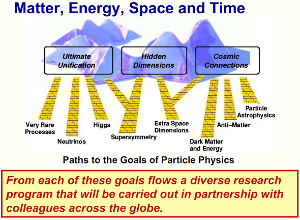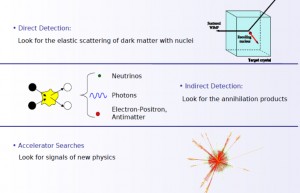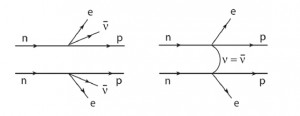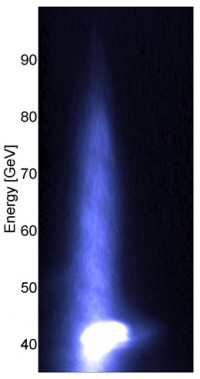
The field of particle physics as defined in the HEPAP Long Range Plan for Particle Physics in 2000, chaired by Jon Bagger and myself
Last week in this column I discussed a special tribute to the Tevatron made at the Division of Particles and Fields (DPF) of the American Physical Society conference at Brown University in Providence, Rhode Island from 9-13 August. This week I will share some of the key points I made in my concluding remarks for this conference. This year’s DPF conference was very well attended and had a programme that broadly covered the field of particle physics and related topics of interest. The DPF plans to organise this conference every second year in the future.

Dark matter is being searched for underground, in space and with accelerators. This central issue in astrophysics may find its resolution in new particles discovered at LHC.
What is particle physics? I began my talk by trying to define the field. There is no universal short definition, but I prefer a rather broad high-level definition of the underlying science goals. The one we used in developing the long-range plan for particle physics for the High Energy Physics Advisory Panel (HEPAP) in 2000 was the study of matter, energy, space and time. From these flow a very diverse research programme. Whatever definition you prefer, the field experimentally has broadened to include not only accelerator-based experiments, but also major experiments underground, at the South Pole and even in space.
Historically, particle physics advanced through the development of higher- and higher-energy accelerators, epitomised by that of both high-energy electron-positron and hadron-hadron colliders. In a sense, the field could have been characterised as an ‘observational science,’ much like astronomy, where we developed a new more powerful telescope (accelerator) from which a series of spectacular discoveries followed. In the modern era, we have evolved from an observational science to an inquiry-based science where the instruments we build are focused on specific scientific questions, often inspired by theory. Examples of such questions are: What is the dark matter? Is the neutrino its own antiparticle? Are there further symmetries in nature?

The observation of neutrinoless double beta decay, shown on the right diagram, would prove that the neutrino is its own antiparticle. The experimental prospects are promising.
The questions we have on our lips are profound and challenging to answer. We often need to develop new instruments involving new technology and large costs. So, despite the richness of the field and the topics and questions we are asking, we must pick and choose among many opportunities. A powerful new accelerator, like the Large Hadron Collider in Switzerland, can address a number of the central questions in the field. At the DPF meeting, we saw the impressive performance of the LHC, promising a large amount of data before the machine is turned off for an extended shutdown, currently scheduled for the end 2012. That shutdown will be used to fix the problems that are currently limiting the energy of the machine to 3.5 teraelectronvolts (TeV) per beam.
At DPF, we saw early results for the Higgs particle that could be characterised by the word ‘maybe.’ This is a significant use of the word, because it means there are hints that could develop into evidence for the Higgs (or go away), and there is the promise to resolve the issue perhaps by the end of the year, or certainly before the shutdown. The early searches for a new symmetry, supersymmetry, have so far come up empty and the experiments are beginning to rule out specific supersymmetric particles up to near a teraelectronvolt.
There are many attractive probes for new particle physics, including underground laboratories that will do the next generation of long baseline neutrino experiments, possibly even observing charge-parity violation for neutrinos. Other attractive experimental areas include the search for dark matter at accelerators (which relates to supersymmetry), in space and underground.
The experimental opportunity that I find particularly attractive is neutrinoless double beta decay, which probes whether the neutrino is its own antiparticle (Majorana neutrinos). One can envision large detectors capable of reaching the atmospheric neutrino mass scale or even the solar neutrino mass scale.
Lastly, one can ask what the future will be for our main experimental tool, high-energy particle accelerators. Will the LHC, or maybe a complementary lepton collider, be our last major high-energy machine? I don’t think so! The main culprit that limits particle accelerators is materials, one way or another. Eliminating materials is the key to the future. Recent advances in developing plasma wakefield accelerators are especially promising.
The electron beam accelerator at SLAC uses two miles (3.22 kilometres) of conventional accelerator to reach 40 GeV and in an experiment using a beam-based plasma wakefield accelerator, electrons were boosted to about 80 GeV in only one metre of acceleration. In other R&D on laser-based plasma wakefield accelerators, advances have been made in controlling both the energy spread and divergence of the beam. Of course, many years of R&D are needed before we can anticipate a new generation of accelerators, but the promise is there, and the next generation of R&D projects is underway.
From my perspective, particle physics may have changed its nature and may have changed its tools, but the prospects remain bright. We have many fundamental problems to address, and are developing tools to address them.



Recent Comments